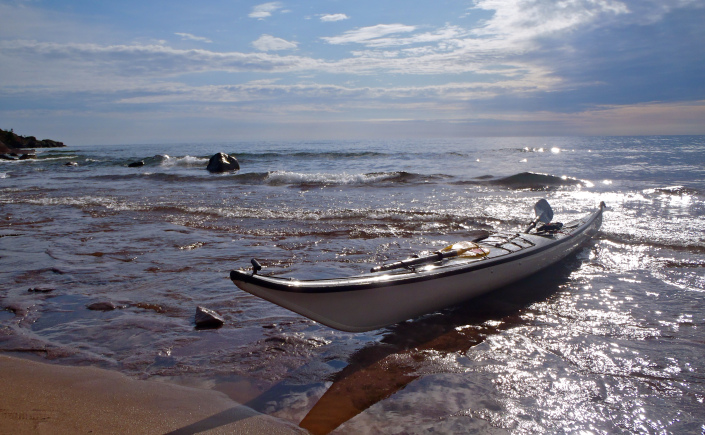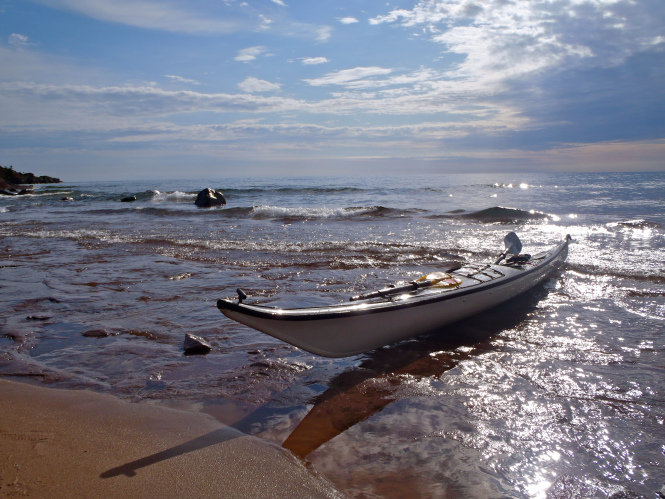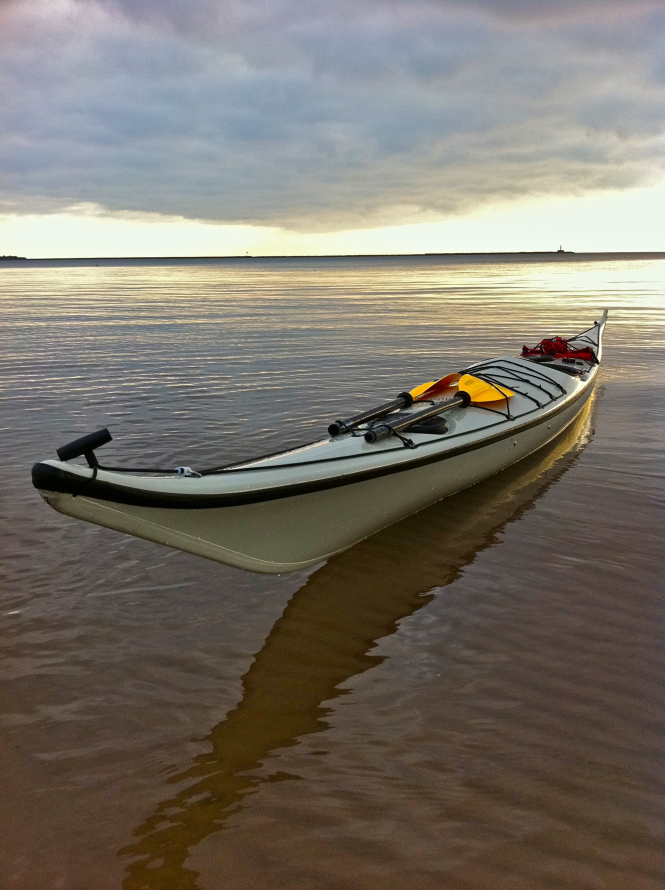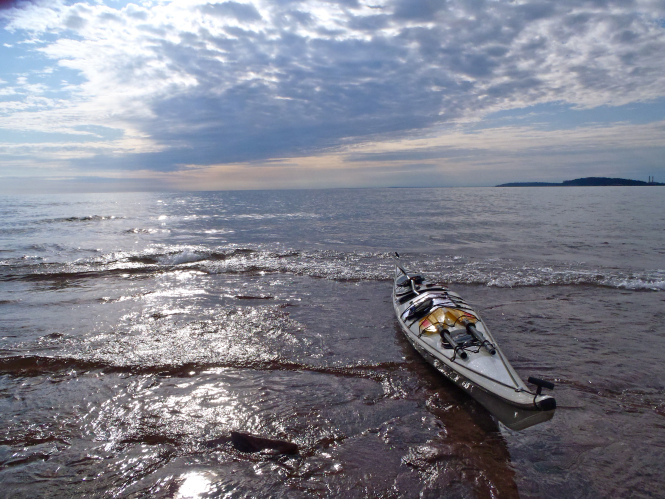This isn’t meant to be a review of the Nordkapp. You’ll find plenty of those online and in magazine archives. Instead, this is an attempt to share my Nordkapp experience in the long term with other paddlers who are thinking of embarking upon the same journey. You should also note that I’m writing about the current Nordkapp, not the older generations of Nordkapp (of which there are many variations), the Nordkapp LV, or the Nordkapp RM. For a history of the Nordkapp’s evolution, see Mike Buckley’s excellent description of the its many incarnations.
To begin with, you should know that my very first experience in a sea kayak was an intimate moment between me and a Nordkapp in 1990. It was absolutely terrifying. I was a 13 year-old interested in paddling, so my parents took me to a local shop’s demo day. Great River Outfitters was there with the Valley line and I was quickly ushered to a Nordkapp with an ocean cockpit and knee tube, put in a sprayskirt, sealed into the boat, and pushed off the beach. What followed must have looked like a combination of claustrophobic terror, a hula dance, and a cat trying to get out of the water.
After miraculously turning around and getting out of the boat without capsizing, I ran to the Necky dealer and bought a Kyook a few weeks later.
Today, I paddle a Nordkapp in all types of seas, including surf, confused reflections, and big swells, with comfort and ease. What’s the difference? First, and most obviously, experience. That demo day moment was literally my first moment in a kayak. In general, a Nordkapp is not a rank beginner’s best friend. Like a Ferrari or an aerobatic airplane, she doesn’t really dance without a skilled hand to guide her. Second, the Nordkapp hull has undergone a few refinements and now shows a bit more initial stability and culture.
It’s a boat that will handle big water, rough seas, and nasty conditions with aplomb and grace, but only to the extent that the paddler is also able to do so. A Nordkapp doesn’t look after a paddler like an SKUK Explorer or P&H Cetus will, but it also doesn’t get in the paddler’s way. I have a regular 10.5 mile course that is used for quick, hard workouts and about half of it is in the reflection zone of breakwalls and big cliffs. With the same perceived effort, my course times only vary by a few minutes between flat water and 4 to 5 foot, confused, reflected seas. The Nordkapp doesn’t know the difference between the two. In fact, I’m often faster in the rough water because the Nordkapp is so happy to surf with very little effort.
Going back to my beginner days, I bought the Kyook because it was the exact opposite of my blind date with the Nordkapp: STABLE! But, within a year, I sold the Kyook and bought a Valley Pintail because my skills surpassed the Kyook that quickly. Like the Pintail, the Nordkapp doesn’t put a cap on your skill development. It will gladly take an edge, lean, or extreme brace without resistance. By gently lifting a knee and weighting the opposite butt cheek, I can keep the edge of the coaming wet without bracing indefinitely. At the same time, that ‘wall’ of stability that some boats feel when on an edge isn’t there. If I lift my knee a little more or let my center of gravity stray toward the outside of the edge, my coaming won’t be the only thing that’s wet.
That stability profile gets into your blood. Boats with more initial stability and boats with a ‘wall’ when on edge seem dull and lifeless now. The liveliness works well for me, especially when I’m in rough water and really do need to brace. In the same way that the wall doesn’t exist when setting an edge, it also doesn’t exist when trying to return to a stable postion. There’s no point of resistance when trying to bring the boat back upright from an extreme brace or a roll.
The Nordkapp, at 18 feet in length, is a long boat. When the hull is held flat, it paddles like a long boat, with excellent top speed, acceleration, and glide. It’s not a flatwater K-1, but it’s still one of the fastest sea kayaks on the water. Those traits make it a pleasure to paddle when catching following seas, launching through surf, paddling a workout, and going long distances with the least effort.
Paddlers often tell me that they’ve heard about how badly the Nordkapp behaves in wind, with a tendency to leecock. That particular trait belongs to the old school Nordkapp HM, with the integral skeg moulded into the stern. The HS, which is now the standard hull, comes with a retractable skeg and behaves with decorum. It will weathercock into the wind, but in anything up to a moderate breeze the boat can be controlled with an edge and the occasional sweep stroke, or by simply trimming your course with the retractable skeg. In heavier winds, the skeg tames any unwanted weathercocking and the boat is immanently controllable.
You would expect an 18 foot boat to be a bit of a pig for day paddles and play, but the Nordkapp is surprisingly responsive. It’s compliance when edging and leaning combine with it’s refined hull contours to make it very maneuverable when handled by a skilled paddler. In flat water, I’m able to turn through 180 degrees with a single, aggressive sweep stroke on the move, followed by an aggressive edge to the outside of the turn, though virtually all of the boat’s momentum is gone by the end of the turn. Surfing, play in rock gardens, and sprightly day paddles are well within the abilities of the boat.
On the downside, the low initial stability can intimidate a new or unsure paddler, preventing him from using the edging and leaning required to make the boat sing when maneuvering. It’s not a comforting design for hesitant paddlers and requires commitment to serve as a rock-solid platform.
It’s also not a boat for smaller paddlers. Unloaded, the freeboard creates excess windage, to the point where I’ll throw some extra gear in the hatches if I’m going out for a short paddle on a windy day. Smaller paddlers will also find that the coaming rises above their pelvis at the hips, making boat control difficult, and that the rear coaming may interfere with layback rolls. At 5’10″, I’m able to comfortably lay back for sweep, Greenland, and hand rolls, but am not sure that would be the case if my torso was any shorter.
It’s also a much more cultured, less twitchy boat with weight in it. A heavier paddler or an expedition load will result in a much mellower boat than when it’s unloaded. I imagine that it’s like throwing pack saddles on a racing pony – the heart and spirit are still the same, but it takes a bit more effort to hit the same strides. Granted, on a long distance trip, the mellowness is a desired trait and not a detriment.
As I’ve gotten older, my biggest criticism is one that I’ve already mentioned: the Nordkapp isn’t a boat that will look after the paddler. Not only does that trait make it a terrible platform for serious photography, but it also means that staying upright if I’m injured or sick would be a bit of a challenge. My Nordkapp won’t coddle me no matter how shredded my body happens to be, and that thought often pops into my head when I’m paddling solo. A partner to raft up with would be a wonderful asset if I pulled a muscle or got sea sick on the water in a Nordkapp.
The last point has led me to a dead-end search for another boat. I’ve paddled a number of other hulls lately and they all disappointment. None of them have the spark that I’m used to, except for other Nordkapps! I’m not a proponent of sticking with a boat or manufacturer because of tradition or legacy. In my 22 years of paddling, I’ve owned more than a dozen boats from at least 6 manufacturers. Some of them have been great boats, but, nonetheless, I still find myself coming back to the Nordkapp.
I can already hear the keyboards tapping as people prepare rebuttals to that statement, but I’m speaking from a purely personal perspective. My paddling style, pedigree, typical mission, and experience work together to make the Nordkapp my match. I would love to find another boat that is an even better match for me. Who wouldn’t? But that would have to be one Hell of a boat, and I haven’t managed to find it yet.
I’ve avoided the typical topics of reviews, like the hatches, deck line arrangement, seats, and cockpit outfitting. All of those things work acceptably on the Nordkapp and, if you don’t like them, they’re mostly changeable and customizable. It’s much more important for me, personally, to find a boat that paddles the way I want it to. The other stuff is just icing that can be changed to fit my needs (or yours).
My Nordkapp was born in 2005 and has a few manufacturing blemishes. There are some gelcoat bubbles and bulges that aren’t very pretty. If I’d bought it new, I may have had an issue with them. But I picked this one up used for a great price and can’t complain. The construction is solid (though not as solid as my early-90s boats were) and has been reliable. I can’t directly comment on the quality of the current Nordkapp construction because I haven’t spent any time in a newer boat, but I’m sure it’s acceptable and safe. The rumors I hear are that the boats coming out of Valley’s molds these days are some of the best they’ve ever built with quality control, but that’s just whispers on the wind, not personal testimony.
The short of it is that the Nordkapp is my personal Swiss Army Kayak. It does everything and it does everything well. In fact, I’m down to a single boat at the moment because the Nordkapp is the boat I always reach for. It has it’s personality quirks, but so do I. Despite those quirks, I happen to really, really like it. And I think it likes me, too.
Resources:






[...] a few weeks ago, I wrote an article about my beloved Nordkapp and mentioned that when I replace her, it would undoubtedly be with another Nordkapp. If I was [...]
Hi
I have a Nordkapp LV, and love the boat for many of the same reasons, it just feels alive all the time..
I am thinking of getting a Nordkapp Jubilee for longer trips, and I wonder whether you find the ocean cockpit good compared to a normal keyhole cockpit.
- How do you find the position of the knees compared to a keyhole cockpit.
- And how easily can you get in and out?!
Any thoughts welcome!
Hugh
Hugh,
I think that it’s all relative to what you’ve become accustomed to. I grew up paddling ocean cockpit Nordkapps and Pintails with kneetubes, so I’m quite at home in them. However, they are inconvenient to get in and out of quickly. I’m on the hunt for a new boat specifically because I want a large, modern cockpit. My suggestion would be that you try an ocean cockpit before you decide to get one.
It’s also worth noting that the Nordkapp Jubilee didn’t come with an ocean cockpit as the standard – it had to be special ordered, as mine was by the original owner. Finding an ocean cockpit Nordkapp Jubilee used could be a bit of a trick!
Best,
Jeremy
Very nice report. I would just add H2O to your title line since there is no such thing as Nordkapp any longer–there are many Nordkapps and they are quite different from each other (like the HM model you note). I started kayaking in an 1987 HS and could not believe how different H2O feels and behaves despite retaining the classic good looks of the original (see my blog for details).
I am also not sure I would call Nordkapp a fast boat. It probably is a bit faster than the other expedition classic NKD Explorer, but that’s about it. I don’t believe a boat with as much rocker as Nordkapp has and as much difference between boat and waterline lengths deserves to be called fast. Just about all American-made expedition boats are significantly faster as are the newer British expedition boats. That’s not a criticism–Nordkapp is plenty fast for an expedition–it’s just a comment about relative designation.
For HUGH: forget about the ocean cockpit! It’s a relic from the days when tight nylon spray decks could not handle waves crashing on decks. They are an inconvenience at best and a safety hazard if you want to push it to the extreme–quick exit from the boat when landing or cowboy self-rescue are both impossible with ocean cockpits. Deck height does not change with ocean vs. keyhole, so you can paddle them both in the same way if you really want to.
Thanks, Haris! This one is actually a Nordkapp Jubilee with an ocean cockpit and a small VCP front hatch, not the current production incarnation with the keyhole cockpit and two oval hatches. It also has about 2 inches more rocker in the stern than the original Nordkapp HS and about 1 inch more than the current production Nordkapp.
The H2O designation was a US market term that Stan used to separate the new deck molds with the dual oval hatches from the old deck molds with the one oval and one round hatches. That doesn’t apply to my boat, so Nordkapp Jubilee is probably the best way to describe what I paddle.
I agree that the Nordkapp isn’t a race-worthy boat, but I’d also say that it’s one of the most consistently fast boats through a variety of conditions. The P&H Cetus, Tiderace Xplore, and some of the other new designs in which I’m just now getting seat time, are certainly right there or even a bit faster through varied conditions, but a lot of the boats that are faster on paper or flat water can’t keep up to a ‘Kapp when the water is rough or confused. That’s based on personal observation, of course, and I have no peer-reviewed, double-blind studies to support my statement. :-)
Hadn’t a chance to paddle the Jubilee. MORE rocker than HS? Is that even possible? So can you paddle it sideways just as fast as forward?
Interesting you mentioned rough water. I had a chance to conduct a double-unblinded HS vs. H2O comparison in 3-4′ wind waves and the H2O was considerably faster due to the fact that HS has insufficient bow buoyancy. HS would bury the nose off the back of every wave, while H2O would slide off nicely. HS would submarine the bow, plow through the water, and lose significant amounts of forward momentum. On flat water I thought the two were comparable–HS may even have a slight edge being an inch narrower and more rounded around the midsection.
Let’s write a grant for a double-blinded trial! Double-blinded paddler–what a concept! :)
2 bonus inches of rocker in the stern quarter on the Jubilee! It’s definitely the most playful of the composite Nordkapps, but nothing like a Pintail, Romany, or even Explorer. They took some of it out when the re-re-designed the hull for the current version.
And, thank goodness, the Jubilee has the increased bow volume compared to the Nordkapp of old so it doesn’t have the diving tendency. It also has a bit of extra width, increased foredeck and decreased aftdeck height, and fuller chines than the old school Nordkapps.
Ironically, the old Nordkapps changed over the 20 years of production, just due to the wear on the mold. Toward the end of the molds life, my Valley and GRO sources say that the boats were coming out close to 19 inches in width instead of 21 due to the years of built up mold release compound. I never saw the mold with my own eyes, but that’s the story.
In your search for a second boat (eg. safety on solo paddles to cope with sickness or injury), you could do worse than the North Shore Atlantic. Lovely boat, feels safe as houses. Also, the Hybrid (Andre Janecki’s Australian design) is an innovative, manouverable and highly stable design, by all accounts.
Thanks for the comment, Paddler9!
I’ve been paddling a Cetus since last August and it does a pretty good job of meeting my needs and wants in a single, all-purpose boat. That said, I haven’t had the opportunity to paddle either the Atlantic or the Hybrid and will keep my eyes and ears open for the change to do so this season.